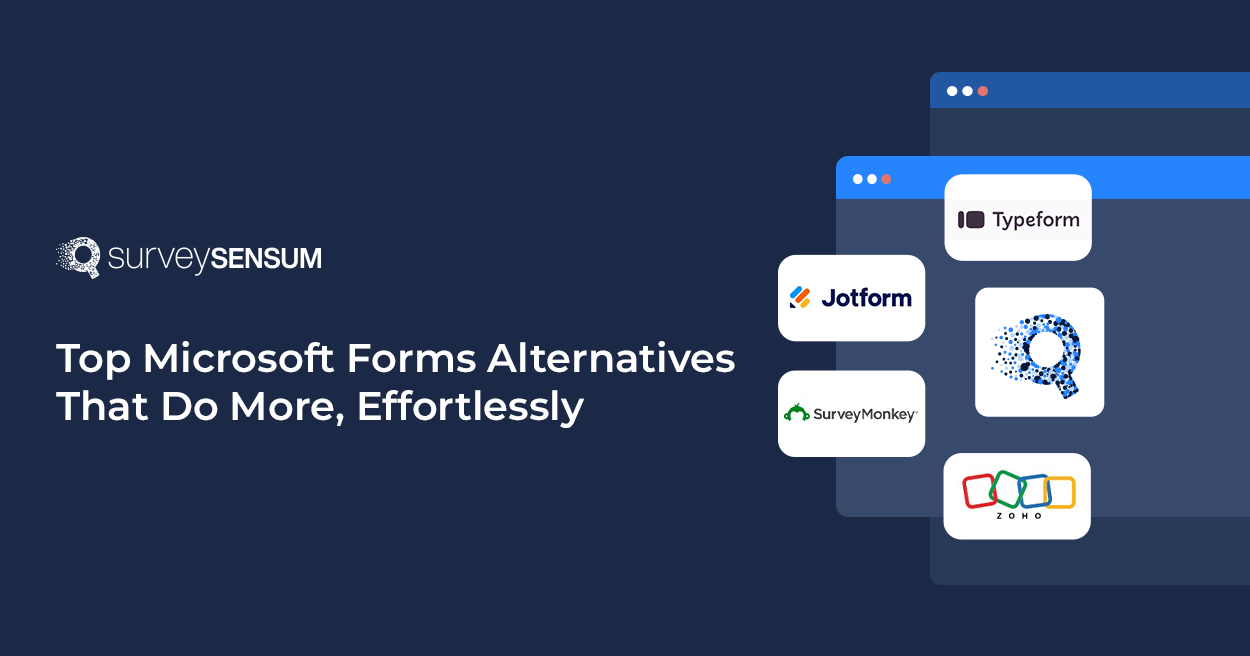
You’re about to launch a new product and need quick, actionable insights from your customers. But how can you gather this information in a way that’s EASY and QUICK for them to answer and STRAIGHTFORWARD for you to analyze?
The answer lies in Multiple Choice Questions (MCQs) — a simple and efficient way to collect clear, actionable data. These surveys are the best for mobile users, which helps boost survey completion rates and ensures your data remains well-organized and ready for analysis.
With the right survey-builder tool, you can effortlessly design MCQ surveys, distribute them across multiple channels, and reach your audience wherever they are. Plus, you’ll gain real-time insights that empower you to act swiftly.
But that’s just the beginning. Surveys featuring multiple choice questions offer even more benefits. Let’s explore these advantages in-depth, along with examples of effective multiple-choice survey questions.
What are Multiple Choice Questions?

Multiple choice questions include a question along with a list of 3-5 options that could be possible answers.
Respondents can choose either one or multiple answers while answering it. This flexibility makes MCQs suitable for various purposes, from testing knowledge to gathering customer feedback. These questions are commonly used in surveys, quizzes, and polls.
For example, if you want to know what drives customers’ choices to purchase from your brand, you must ask the multiple choice question with the following options:
→ Q. Which of the following factors influenced your decision to purchase our product? [Select all that apply]
- Price quality
- Brand reputation
- Product feature
- Recommendation from friend or family
- Online reviews
By asking this question, you get clear, reliable customer insights diving into important factors in customers’ purchasing decisions.
Why Use Multiple Choice Questions?
Using multiple choice questions offers several key benefits that make them a powerful tool for surveys and assessments. Here are the following reasons:
- Simplify Data Collection: Multiple-choice questions make it straightforward to gather responses by offering a set of predefined options.
- Organize Responses: They structure answers in a way that is easy to review and categorize, reducing ambiguity.
- Speed-Up Analysis: With clearly defined choices, analyzing the data becomes quicker and more efficient, helping you get insights faster.
- Versatile Use: Ideal for various purposes such as evaluating learning outcomes, gauging customer satisfaction, and performing market research.
- Generate Actionable Insights: They provide clear and direct data that you can easily use to make informed decisions and improvements.
Overall, using multiple choice questions helps you gather data more effectively, analyze it more easily, and gain clearer insights into your customer’s preferences and behaviors.
10 Types of Multiple-Choice Questions
There are ten different types of multiple-choice questions that you can choose to create the right format while designing your surveys, quizzes, or assessments, as per your unique purpose and provide specific benefits. Let’s have a look here:
1. Single-Select Multiple Choice Questions

Single-select questions offer a list of options, from which respondents choose just one answer.
These questions are valuable for obtaining a clear, definitive response when only one option is relevant. They are straightforward and make it easy to categorize answers.
To create a single-select MCQ, ask a question with multiple possible answers but restrict respondents to select only one option. This format is ideal for questions where a single choice defines the respondent’s primary preference or opinion.
Example: What is your preferred method of communication? (Select only one)
- Phone
- Text message
- In-person
2. Multi-Select Multiple Choice Questions

Multi-select questions allow respondents to choose answers from more than one option from the given list.
These questions are useful for capturing multiple facets of a respondent’s opinion or experience. They provide a more nuanced understanding of preferences or behaviors when multiple answers can apply. So, frame your question so that respondents can select multiple answers. Ensure the question is clear about whether selecting more than one option is allowed.
Example: Which features do you consider when buying a new laptop? (Select all that apply)
- Battery life
- Processor speed
- Storage capacity
- Brand reputation
- Price
3. Dropdown Menu Multiple Choice Questions

Dropdown menu multiple-choice questions let you choose an answer from a list that appears in a dropdown format.
Use this type when you have many options, as it saves space and keeps your survey neat. It’s great for detailed questions about demographics or preferences. To set this up, create a dropdown with a list of options for respondents to select from.
Example: What is your highest level of education?
- High school
- Associate degree
- Bachelor’s degree
- Master’s degree
- Doctorate
4. Star Rating Multiple Choice Questions

Star rating MCQs let respondents rate an item or experience on a scale using stars.
This format helps respondents quickly show their level of satisfaction or opinion in a visual and easy-to-understand way. It’s engaging and works well on mobile devices. To use this, set up a question where respondents can rate their experience on a star scale.
Example: How would you rate our customer service?
- ★☆☆☆☆ (Very Poor)
- ★★☆☆☆ (Poor)
- ★★★☆☆ (Average)
- ★★★★☆ (Good)
- ★★★★★ (Excellent)
5. Text Slider Multiple Choice Questions
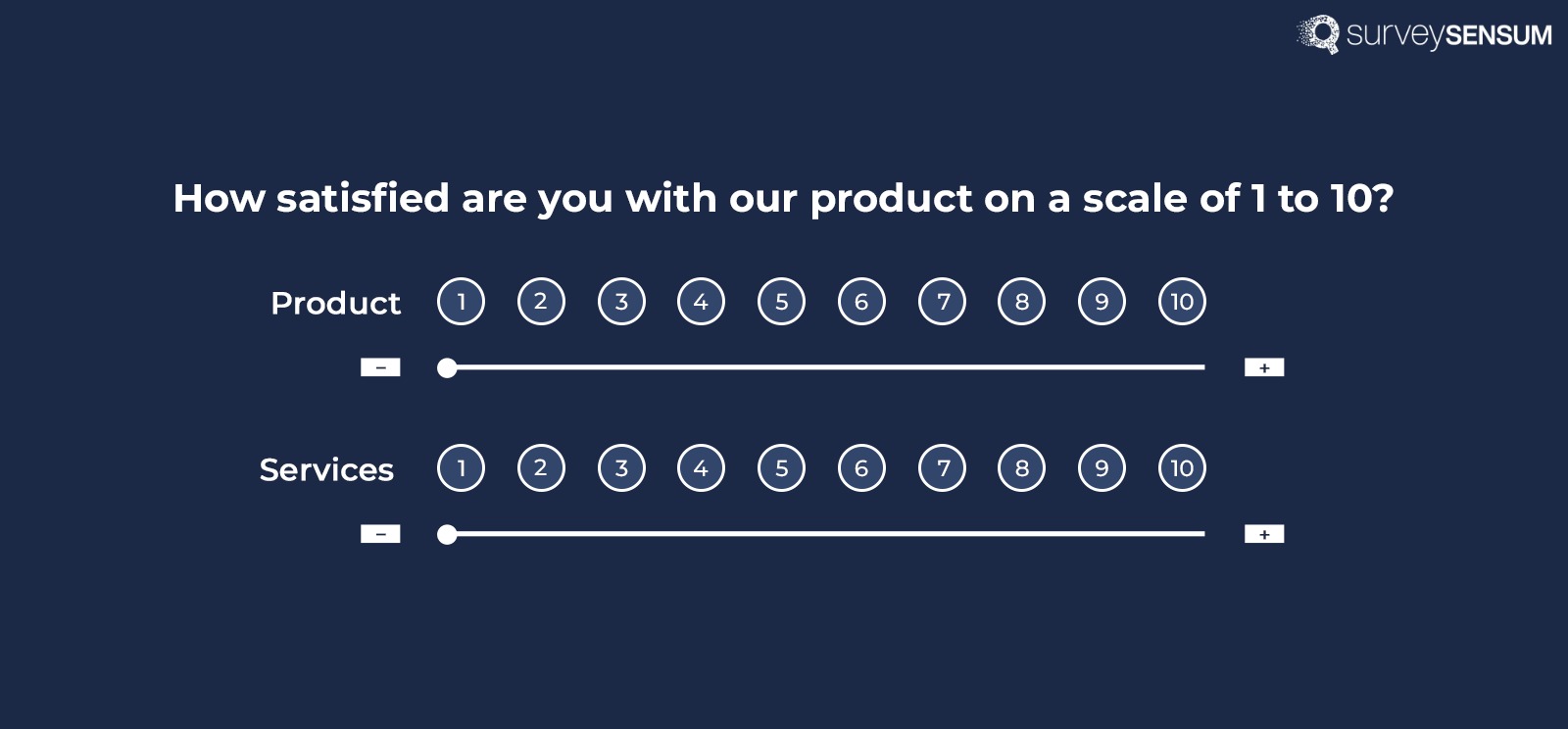
Text slider MCQs allow respondents to select a value by sliding a control along a scale.
This format is great for capturing responses on a continuous scale, giving you more detail than fixed options. It helps respondents show varying degrees of opinion or satisfaction. To use this type, set up a slider with labels at each end to represent the range of possible responses.
Example: How satisfied are you with our product on a scale of 1 to 10?
(Slider ranges from 1 to 10)
6. Numeric Slider Multiple Choice Questions
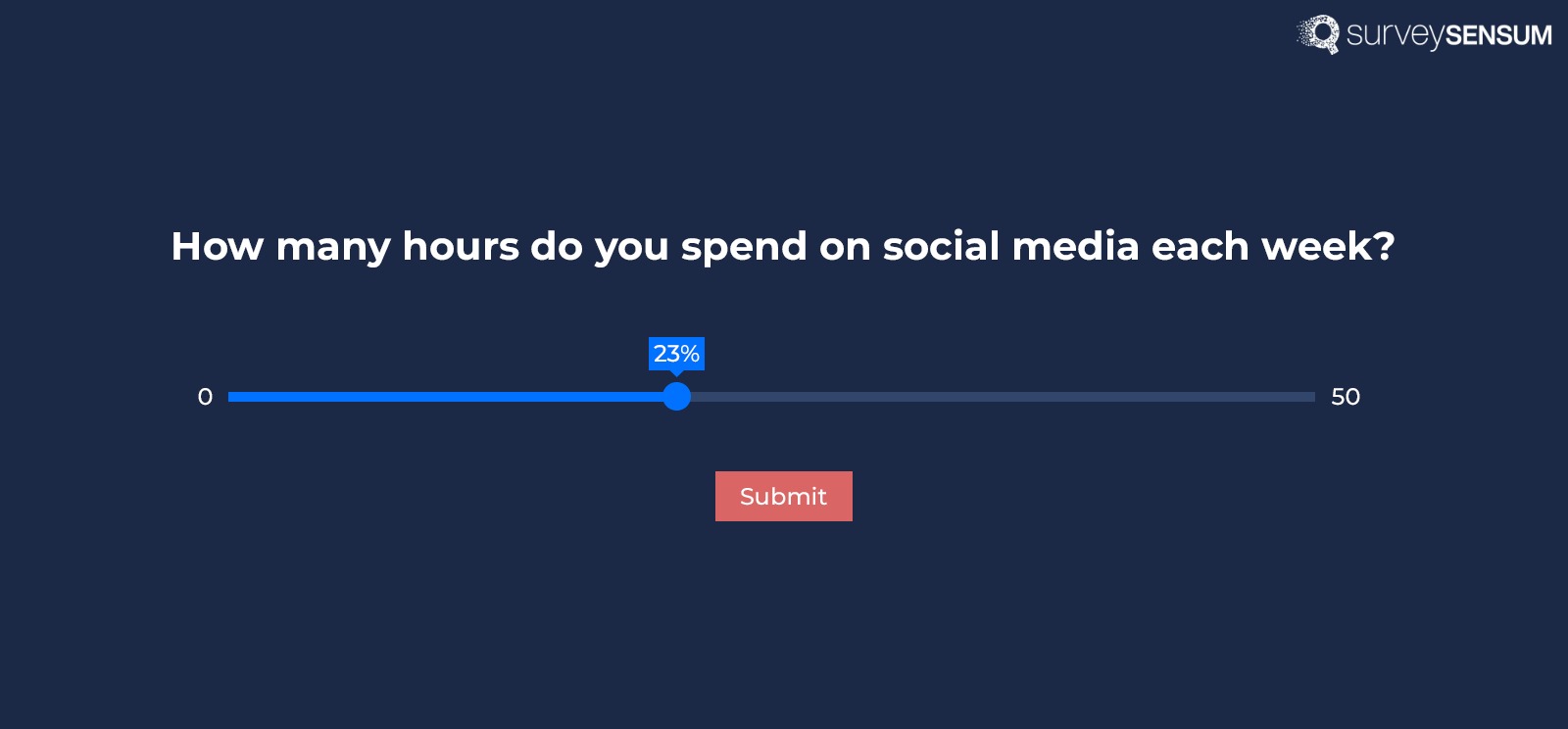
Numeric slider multiple-choice questions let respondents select a numeric value from a range.
This approach provides a precise quantitative measure, making it ideal for questions that need specific numerical input. It simplifies collecting data on numerical preferences or estimates. To use this type, set up a slider with a numeric range for respondents to choose from.
Example: How many hours do you spend on social media each week?
(Slider ranges from 0 – 50 hours)
7. Thumbs Up/Down Multiple Choice Questions

Thumbs up/down multiple-choice questions let respondents choose between a thumbs up (approve) or thumbs down (disapprove).
This simple format quickly captures overall sentiment or approval. It’s effective for straightforward feedback and immediate reactions. To use this type, ask a question with two clear options, for respondents to indicate their approval or disapproval. This type is useful for obtaining fast, binary feedback on a specific aspect.
Example: Did you enjoy your recent visit to our store?
👍 Yes
👎 No
8. Matrix Table Multiple Choice Questions
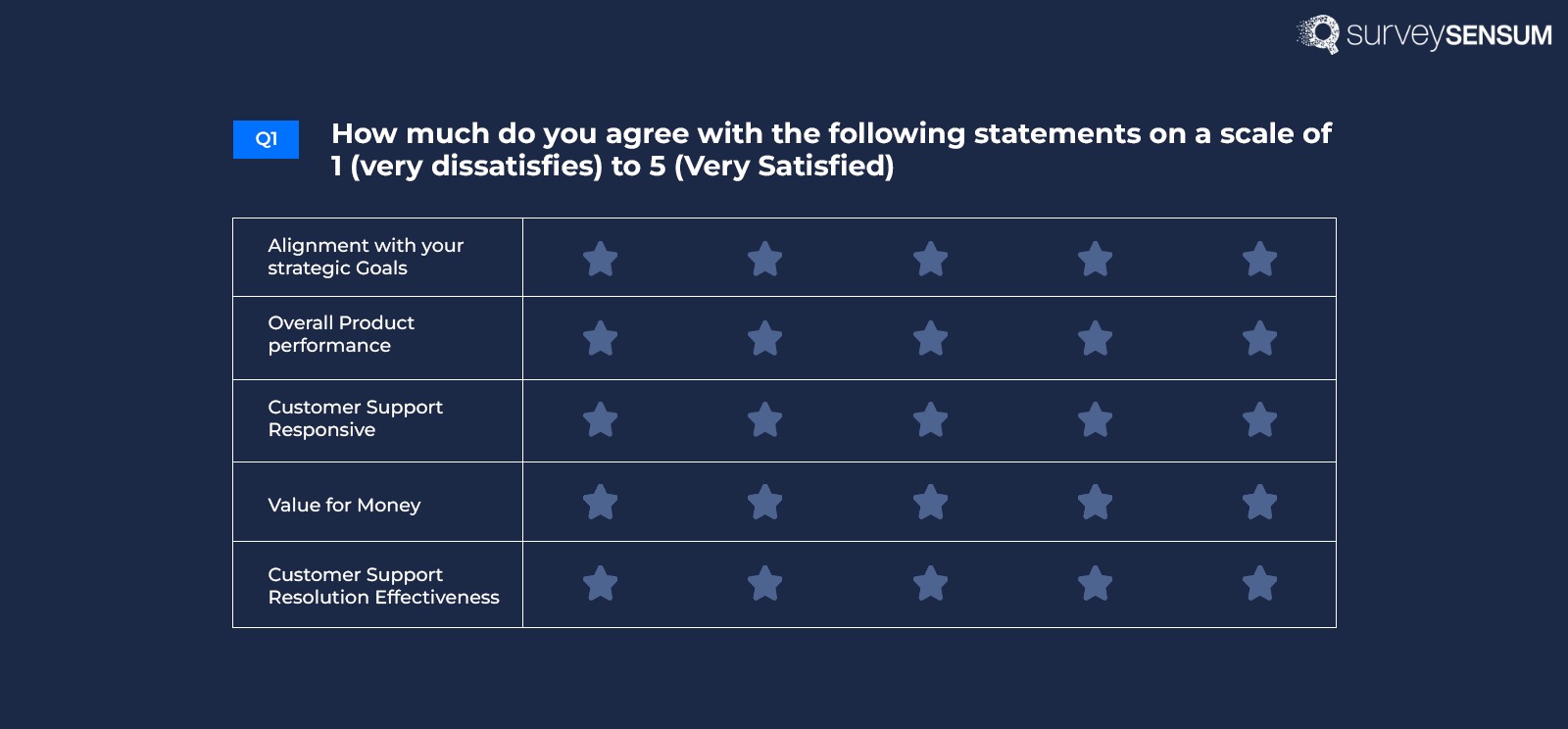
Matrix table multiple-choice questions present several statements in a grid, where respondents rate each statement using the same scale.
This format efficiently collects responses on multiple related items simultaneously, making it ideal for comparing various attributes or questions that share the same response options. To use this type, set up a table with statements in rows and a rating scale in columns. Respondents then select a rating for each statement, offering a detailed overview of their opinions.
Example: Please rate the following aspects of our service:
| Aspect | Poor | Fair | Good | Very Good | Excellent |
| Quality of support | ☐ | ☐ | ☐ | ☐ | ☐ |
| Speed of response | ☐ | ☐ | ☐ | ☐ | ☐ |
| Friendliness of staff | ☐ | ☐ | ☐ | ☐ | ☐ |
| Ease of communication | ☐ | ☐ | ☐ | ☐ | ☐ |
| Overall satisfaction | ☐ | ☐ | ☐ | ☐ | ☐ |
9. Rank Order Multiple Choice Questions
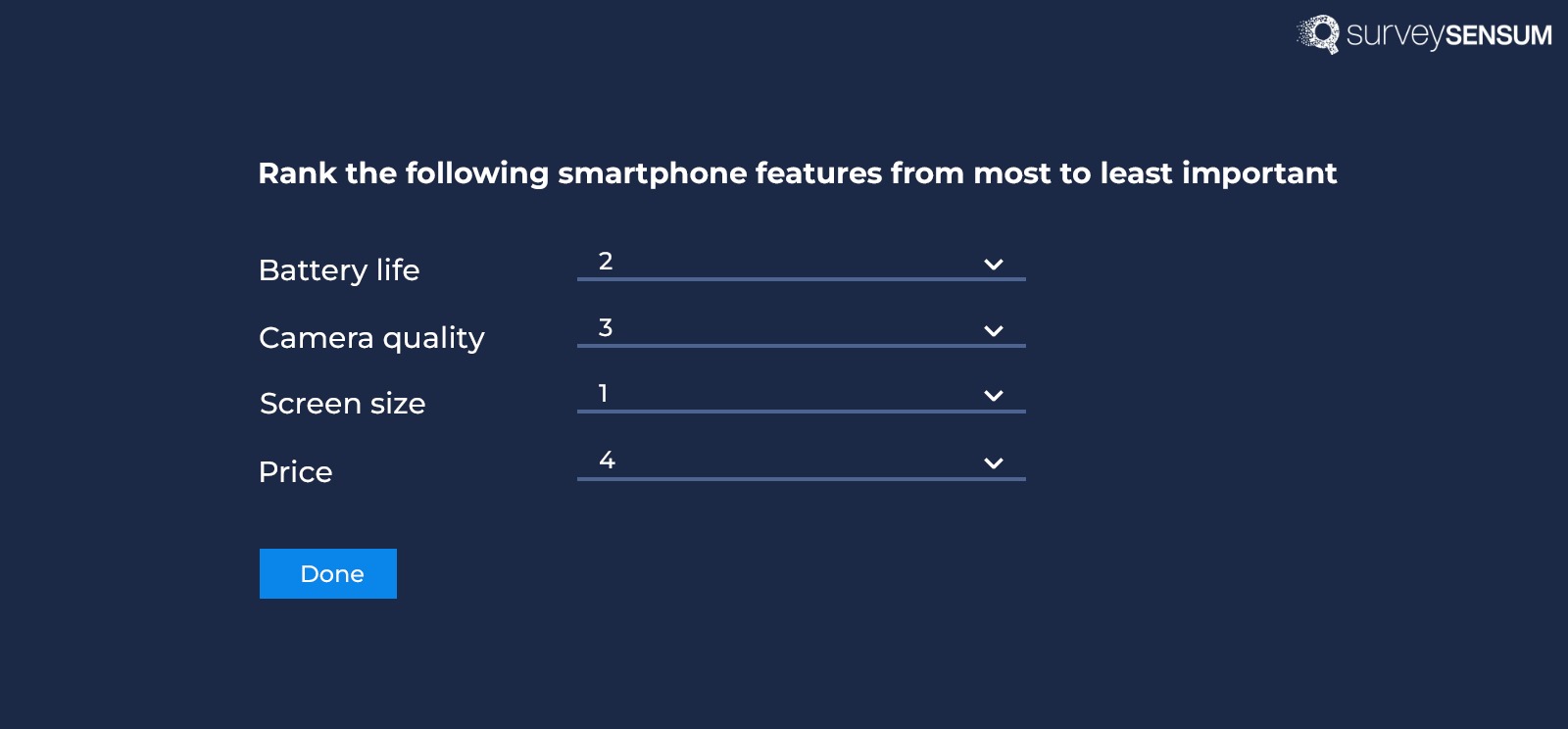
Rank-order multiple-choice questions ask respondents to arrange options in their order of preference or importance.
This helps you understand how respondents prioritize different items, providing valuable insights into their preferences. To use this format, list several options and have respondents rank them according to their preference. This approach reveals which choices are most important or appealing to your audience.
Example: Rank the following smartphone features from most to least important:
- Battery life
- Camera quality
- Screen size
- Price
10. Image/Picture-Based Multiple Choice Questions

Image/picture-based multiple-choice questions use images instead of text for response options.
This image survey format makes your survey more engaging and is great for questions that involve visual preferences or recognitions. To implement this, display images as the response choices, ensuring each one is clear and relevant to the question. This approach helps respondents make choices based on visual cues.
Example: Which of these designs do you prefer for our new product?
- [Image of Design A]
- [Image of Design B]
- [Image of Design C]
- [Image of Design D]
Now that you know the types of multiple choice questions, let’s glance at the examples here.
Launch your multiple-choice question survey with readymade customizable templates offered by the SurveySensum tool within minutes. Sign up today for free
28 Multiple Choice Survey Questions Examples
Here are examples of multiple choice questions that you can include while creating a survey:
Question To Ask:
- Which product do you like the most? (Single Select)
- Which of the following activities do you enjoy the most? (Multi-Select)
- How did you hear about us? (Dropdown Menu)
- Rate your experience with our customer service. (Star Rating)
- How likely are you to recommend our product to a friend? (Numeric Slider)
- Do you prefer online shopping? (Thumbs Up/Down)
- Which features of our product do you use most often? (Multi-Select)
- On a scale of 1 to 5, how satisfied are you with our service? (Star Rating)
- Rank the following aspects of our service in order of importance. (Order)
- Select all the tools you use daily. (Multi-Select)
- Which of these services would you like us to offer? (Dropdown Menu)
- How would you rate the quality of our website? (Star Rating)
- What is your preferred method of communication? (Dropdown Menu)
- How many times have you visited our store in the past month? (Numeric Slider)
- Rate the following aspects of our app. (Matrix Table including easy to use, overall satisfaction, communication support)
- How often do you purchase this product from our brand? (Dropdown Menu)
- What improvements would you like to see in our product? (Multi-Select)
- How would you rate our product’s value for money? (Star Rating)
- Which platform do you prefer for news? (Single Select)
- How many different products have you purchased from us? (Numeric Slider)
- How would you describe your overall satisfaction with our service? (Star Rating)
- Rank the following features in terms of importance. (Rank Order)
- What factors influenced your purchase decision? (Multi-Select)
- How do you rate our product’s durability? (Star Rating)
- How do you usually find out about new products? (Dropdown Menu)
- What is your preferred time of day for receiving promotions? (Dropdown Menu)
- How would you rate the ease of use of our website? (Star Rating)
- Do you prefer receiving updates via email or SMS? (Single Select)
Conclusion
As we wrap up, it’s clear how versatile and valuable these multiple choice questions are in collecting and analyzing data. MCQs simplify the process of gathering responses, making it easier to understand and act on the information you collect. Whether you’re creating a survey, a quiz, or a poll, using MCQs can streamline your process and provide clear, actionable insights.
To create an MCQ survey effectively, use an effective survey-building tool like SurveySensum. With its AI Text Analytics, you assess gathered customer insights in real time. Also, the structured format of MCQs ensures you get precise, valuable feedback without overwhelming your audience.













